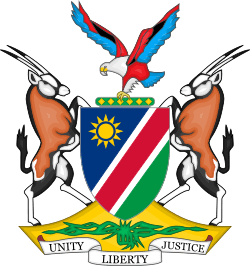India–Namibia relations
India–Namibia relations refers to the current and historical relationship between India and Namibia. India has a high commissioner in Windhoek[1] and Namibia has a high commissioner in New Delhi. Namibia's high commissioner is also accredited for Bangladesh, the Maldives and Sri Lanka.[2] In 2010, relations were described by Indian officials as "warm and cordial".[3]
 | |
India |
Namibia |
|---|---|
Liberation movement
India was one of SWAPO's earliest supporters during the Namibian liberation movement. The first SWAPO embassy was established in India in 1986. India's observer mission was converted to a full High Commission on Namibia's independence day of 21 March 1990.[3]
Since independence
India has helped train the Namibian Air Force since its creation in 1995. The two countries work closely in mutual multilateral organisations such as the United Nations, Non-Aligned Movement and the Commonwealth of Nations. Namibia supports expansion of the United Nations Security Council to include a permanent seat for India.[3]
Visits
A number of high-ranking Indian officials have visited Namibia since independence in 1990; Indian Prime Minister V. P. Singh, former Prime Minister Rajiv Gandhi and other high-ranking politicians were in Namibia for its independence day celebrations in 1990. President Shankar Dayal Sharma visited Namibia in 1995 and Prime Minister Atal Bihari Vajpayee visited in 1998 as well as numerous ministerial visits.[3] In July 2010, Minister of State for External Affairs Preneet Kaur visited Namibia ahead of the 13th Exim Bank Conclave on India Africa Project Partnership.[3] President Pranab Mukherjee visited Namibia from 15-17, 2016. [4]
A number of high-ranking Namibian officials have visited India as well; as of 2010, President Sam Nujoma had visited India 11 times.[3] In August–September 2009, Namibian President Hifikepunye Pohamba made his first visit as President to India.[5] 43 business leaders and politicians accompanied Pohamba on the trip, which took them to New Delhi, Mumbai, Bangalore and Agra.[6]
Trade and investment
In 2008–09, trade between the two countries stood at approximately US$80 million. Namibia's main imports from India were drugs and pharmaceuticals, chemicals, agricultural machinery, automobile and automobile parts, glass and glassware, plastic and linoleum products. India primarily imported nonferrous metals, ores and metal scarps. Indian products are also exported to neighboring South Africa and re-imported to Namibia as South African imports. Namibian diamonds are often exported to European diamond markets before being again imported to India. In 2009, the first direct sale of Namibian diamonds to India took place.[3] In 2008, two Indian companies won a US$105 million contract from NamPower to lay a high-voltage direct current bi-polar line from Katima Mulilo to Otjiwarongo.[3] Namibia is a beneficiary of the Indian Technical and Economic Cooperation (ITEC) programme for telecommunications professionals from developing countries.[6]
References
- High Commission of India in Namibia Archived 2013-07-03 at the Wayback Machine
- "High Commission of the Republic of Namibia in the Republic of India". Archived from the original on 2018-03-14. Retrieved 2011-01-07.
- Indo-Namibian Relations Archived 2012-03-13 at the Wayback Machine Ministry of External Affairs of India, September 2010
- "Visit of President to Namibia (June 15-17, 2016)". mea.gov.in. Retrieved 2020-05-08.
- India, Namibia sign mineral, energy agreements IndianExpress.com, 1 September 2009
- Pohamba Visits India New Era, 31 August 2009

